Constraints on the Formation of M31’s Stellar Halo from the SPLASH Survey
Abstract
:1. Introduction
2. The SPLASH Survey
3. The Properties of M31’s Halo Measured by SPLASH
3.1. Global Properties of Andromeda’s Stellar Halo
3.1.1. Surface Brightness and Metallicity Profiles
3.1.2. Stellar Velocity Dispersion
3.2. Tidal Debris Features
3.3. Andromeda’s Inner Halo
4. Conclusions
Acknowledgments
Conflicts of Interest
Abbreviations
| M31 | Andromeda |
| MW | Milky Way |
| PAndAS | Pan-Andromeda Archaeological Survey |
| PHAT | Panchromatic Hubble Andromeda Treasury |
| RGB | red giant branch |
| SPLASH | Spectroscopic and Photometric Landscape of Andromeda’s Stellar Halo |
References
- Johnston, K.V.; Bullock, J.S.; Sharma, S.; Font, A.; Robertson, B.E.; Leitner, S.N. Tracing Galaxy Formation with Stellar Halos. II. Relating Substructure in Phase and Abundance Space to Accretion Histories. Astrophys. J. 2008, 689, 936–957. [Google Scholar] [CrossRef]
- Bullock, J.S.; Johnston, K.V. Tracing Galaxy Formation with Stellar Halos. I. Methods. Astrophys. J. 2005, 635, 931–949. [Google Scholar] [CrossRef]
- Cooper, A.P.; Cole, S.; Frenk, C.S.; White, S.D.M.; Helly, J.; Benson, A.J.; De Lucia, G.; Helmi, A.; Jenkins, A.; Navarro, J.F.; et al. Galactic stellar haloes in the CDM model. Mon. Not. R. Astron. Soc. 2010, 406, 744–766. [Google Scholar] [CrossRef] [Green Version]
- Font, A.S.; McCarthy, I.G.; Crain, R.A.; Theuns, T.; Schaye, J.; Wiersma, R.P.C.; Vecchia, C.D. Cosmological simulations of the formation of the stellar haloes around disc galaxies. Mon. Not. R. Astron. Soc. 2011, 416, 2802–2820. [Google Scholar] [CrossRef]
- Tissera, P.B.; Beers, T.C.; Carollo, D.; Scannapieco, C. Stellar haloes in Milky Way mass galaxies: From the inner to the outer haloes. Mon. Not. R. Astron. Soc. 2014, 439, 3128–3138. [Google Scholar] [CrossRef]
- McConnachie, A.W.; Irwin, M.J.; Ibata, R.A.; Dubinski, J.; Widrow, L.M.; Martin, N.F.; Côté, P.; Dotter, A.L.; Navarro, J.F.; Ferguson, A.M.N.; et al. The remnants of galaxy formation from a panoramic survey of the region around M31. Nature 2009, 461, 66–69. [Google Scholar] [CrossRef] [PubMed]
- Ibata, R.A.; Lewis, G.F.; McConnachie, A.W.; Martin, N.F.; Irwin, M.J.; Ferguson, A.M.N.; Babul, A.; Bernard, E.J.; Chapman, S.C.; Collins, M.; et al. The Large-scale Structure of the Halo of the Andromeda Galaxy. I. Global Stellar Density, Morphology and Metallicity Properties. Astrophys. J. 2014, 780, 128. [Google Scholar] [CrossRef]
- Dalcanton, J.J.; Williams, B.F.; Lang, D.; Lauer, T.R.; Kalirai, J.S.; Seth, A.C.; Dolphin, A.; Rosenfield, P.; Weisz, D.R.; Bell, E.F.; et al. The Panchromatic Hubble Andromeda Treasury. Astrophys. J. Suppl. 2012, 200, 18. [Google Scholar] [CrossRef]
- Gilbert, K.M.; Tollerud, E.; Beaton, R.L.; Guhathakurta, P.; Bullock, J.S.; Chiba, M.; Kalirai, J.S.; Kirby, E.N.; Majewski, S.R.; Tanaka, M. Global Properties of M31’s Stellar Halo From the SPLASH Survey: III. Measuring the Stellar Velocity Dispersion Profile. Astrophys. J. 2017. submitted. [Google Scholar]
- Palma, C.; Majewski, S.R.; Siegel, M.H.; Patterson, R.J.; Ostheimer, J.C.; Link, R. Exploring Halo Substructure with Giant Stars. IV. The Extended Structure of the Ursa Minor Dwarf Spheroidal Galaxy. Astron. J. 2003, 125, 1352–1372. [Google Scholar] [CrossRef]
- Guhathakurta, P.; Ostheimer, J.C.; Gilbert, K.M.; Rich, R.M.; Majewski, S.R.; Kalirai, J.S.; Reitzel, D.B.; Patterson, R.J. Discovery of an extended halo of metal-poor stars in the Andromeda spiral galaxy. ArXiv, 2005; arXiv:astro-ph/0502366. [Google Scholar]
- Gilbert, K.M.; Guhathakurta, P.; Kalirai, J.S.; Rich, R.M.; Majewski, S.R.; Ostheimer, J.C.; Reitzel, D.B.; Cenarro, A.J.; Cooper, M.C.; Luine, C.; et al. A New Method for Isolating M31 Red Giant Stars: The Discovery of Stars out to a Radial Distance of 165 kpc. Astrophys. J. 2006, 652, 1188–1212. [Google Scholar] [CrossRef]
- Kalirai, J.S.; Gilbert, K.M.; Guhathakurta, P.; Majewski, S.R.; Ostheimer, J.C.; Rich, R.M.; Cooper, M.C.; Reitzel, D.B.; Patterson, R.J. The Metal-poor Halo of the Andromeda Spiral Galaxy (M31). Astrophys. J. 2006, 648, 389–404. [Google Scholar] [CrossRef]
- Courteau, S.; Widrow, L.M.; McDonald, M.; Guhathakurta, P.; Gilbert, K.M.; Zhu, Y.; Beaton, R.L.; Majewski, S.R. The Luminosity Profile and Structural Parameters of the Andromeda Galaxy. Astrophys. J. 2011, 739, 20–36. [Google Scholar] [CrossRef]
- Majewski, S.R.; Beaton, R.L.; Patterson, R.J.; Kalirai, J.S.; Geha, M.C.; Muñoz, R.R.; Seigar, M.S.; Guhathakurta, P.; Gilbert, K.M.; Rich, R.M.; et al. Discovery of Andromeda XIV: A Dwarf Spheroidal Dynamical Rogue in the Local Group? Astrophys. J. Lett. 2007, 670, L9–L12. [Google Scholar] [CrossRef]
- Kalirai, J.S.; Zucker, D.B.; Guhathakurta, P.; Geha, M.; Kniazev, A.Y.; Martínez-Delgado, D.; Bell, E.F.; Grebel, E.K.; Gilbert, K.M. The SPLASH Survey: A Spectroscopic Analysis of the Metal-Poor, Low-Luminosity M31 dSph Satellite Andromeda X. Astrophys. J. 2009, 705, 1043–1055. [Google Scholar] [CrossRef]
- Howley, K.M.; Geha, M.; Guhathakurta, P.; Montgomery, R.M.; Laughlin, G.; Johnston, K.V. Darwin Tames an Andromeda Dwarf: Unraveling the Orbit of NGC 205 Using a Genetic Algorithm. Astrophys. J. 2008, 683, 722–749. [Google Scholar] [CrossRef]
- Kalirai, J.S.; Beaton, R.L.; Geha, M.C.; Gilbert, K.M.; Guhathakurta, P.; Kirby, E.N.; Majewski, S.R.; Ostheimer, J.C.; Patterson, R.J.; Wolf, J. The SPLASH Survey: Internal Kinematics, Chemical Abundances, and Masses of the Andromeda I, II, III, VII, X, and XIV Dwarf Spheroidal Galaxies. Astrophys. J. 2010, 711, 671–692. [Google Scholar] [CrossRef]
- Tollerud, E.J.; Beaton, R.L.; Geha, M.C.; Bullock, J.S.; Guhathakurta, P.; Kalirai, J.S.; Majewski, S.R.; Kirby, E.N.; Gilbert, K.M.; Yniguez, B.; et al. The SPLASH Survey: Spectroscopy of 15 M31 Dwarf Spheroidal Satellite Galaxies. Astrophys. J. 2012, 752, 45. [Google Scholar] [CrossRef]
- Ho, N.; Geha, M.; Munoz, R.R.; Guhathakurta, P.; Kalirai, J.; Gilbert, K.M.; Tollerud, E.; Bullock, J.; Beaton, R.L.; Majewski, S.R. Stellar Kinematics of the Andromeda II Dwarf Spheroidal Galaxy. Astrophys. J. 2012, 758, 124. [Google Scholar] [CrossRef]
- Howley, K.M.; Guhathakurta, P.; van der Marel, R.; Geha, M.; Kalirai, J.; Yniguez, B.; Kirby, E.; Cuillandre, J.C.; Gilbert, K. Internal Stellar Kinematics of M32 from the SPLASH Survey: Dark Halo Constraints. Astrophys. J. 2013, 765, 65. [Google Scholar] [CrossRef]
- Dorman, C.E.; Guhathakurta, P.; Seth, A.C.; Weisz, D.R.; Bell, E.F.; Dalcanton, J.J.; Gilbert, K.M.; Hamren, K.M.; Lewis, A.R.; Skillman, E.D.; et al. A Clear Age-Velocity Dispersion Correlation in Andromeda’s Stellar Disk. Astrophys. J. 2015, 803, 24. [Google Scholar] [CrossRef]
- McConnachie, A.W.; Huxor, A.; Martin, N.F.; Irwin, M.J.; Chapman, S.C.; Fahlman, G.; Ferguson, A.M.N.; Ibata, R.A.; Lewis, G.F.; Richer, H.; et al. A Trio of New Local Group Galaxies with Extreme Properties. Astrophys. J. 2008, 688, 1009–1020. [Google Scholar] [CrossRef]
- Dorman, C.E.; Widrow, L.M.; Guhathakurta, P.; Seth, A.C.; Foreman-Mackey, D.; Bell, E.F.; Dalcanton, J.J.; Gilbert, K.M.; Skillman, E.D.; Williams, B.F. A New Approach to Detailed Structural Decomposition from the SPLASH and PHAT Surveys: Kicked-up Disk Stars in the Andromeda Galaxy? Astrophys. J. 2013, 779, 103. [Google Scholar] [CrossRef]
- Gilbert, K.M.; Fardal, M.; Kalirai, J.S.; Guhathakurta, P.; Geha, M.C.; Isler, J.; Majewski, S.R.; Ostheimer, J.C.; Patterson, R.J.; Reitzel, D.B.; et al. Stellar Kinematics in the Complicated Inner Spheroid of M31: Discovery of Substructure along the Southeastern Minor Axis and Its Relationship to the Giant Southern Stream. Astrophys. J. 2007, 668, 245–267. [Google Scholar] [CrossRef]
- Gilbert, K.M.; Guhathakurta, P.; Kollipara, P.; Beaton, R.L.; Geha, M.C.; Kalirai, J.S.; Kirby, E.N.; Majewski, S.R.; Patterson, R.J. The Splash Survey: A Spectroscopic Portrait of Andromeda’s Giant Southern Stream. Astrophys. J. 2009, 705, 1275–1297. [Google Scholar] [CrossRef]
- Gilbert, K.M.; Guhathakurta, P.; Beaton, R.L.; Bullock, J.; Geha, M.C.; Kalirai, J.S.; Kirby, E.N.; Majewski, S.R.; Ostheimer, J.C.; Patterson, R.J.; et al. Global Properties of M31’s Stellar Halo from the SPLASH Survey. I. Surface Brightness Profile. Astrophys. J. 2012, 760, 76. [Google Scholar] [CrossRef]
- Williams, B.F.; Dalcanton, J.J.; Bell, E.F.; Gilbert, K.M.; Guhathakurta, P.; Lauer, T.R.; Seth, A.C.; Kalirai, J.S.; Rosenfield, P.; Girardi, L. The Panchromatic Hubble Andromeda Treasury. II. Tracing the Inner M31 Halo with Blue Horizontal Branch Stars. Astrophys. J. 2012, 759, 46. [Google Scholar] [CrossRef]
- Williams, B.F.; Dalcanton, J.J.; Bell, E.F.; Gilbert, K.M.; Guhathakurta, P.; Dorman, C.; Lauer, T.R.; Seth, A.C.; Kalirai, J.S.; Rosenfield, P.; et al. Tracing the Metal-poor M31 Stellar Halo with Blue Horizontal Branch Stars. Astrophys. J. 2015, 802, 49. [Google Scholar] [CrossRef]
- Seigar, M.S.; Barth, A.J.; Bullock, J.S. A revised Λ CDM mass model for the Andromeda Galaxy. Mon. Not. R. Astron. Soc. 2008, 389, 1911–1923. [Google Scholar] [CrossRef]
- Vargas, L.C.; Geha, M.C.; Tollerud, E.J. The Distribution of Alpha Elements in Andromeda Dwarf Galaxies. Astrophys. J. 2014, 790, 73. [Google Scholar] [CrossRef]
- Vargas, L.C.; Gilbert, K.M.; Geha, M.; Tollerud, E.J.; Kirby, E.N.; Guhathakurta, P. [α/Fe] Abundances of Four Outer M31 Halo Stars. Astrophys. J. Lett. 2014, 797, L2. [Google Scholar] [CrossRef]
- Kirby, E.N.; Cohen, J.G.; Guhathakurta, P.; Cheng, L.; Bullock, J.S.; Gallazzi, A. The Universal Stellar Mass-Stellar Metallicity Relation for Dwarf Galaxies. Astrophys. J. 2013, 779, 102. [Google Scholar] [CrossRef]
- Gilmore, G.; Wyse, R.F.G. Element Ratios and the Formation of the Stellar Halo. Astron. J. 1998, 116, 748–753. [Google Scholar] [CrossRef] [Green Version]
- Gilbert, K.M.; Font, A.S.; Johnston, K.V.; Guhathakurta, P. The Dominance of Metal-rich Streams in Stellar Halos: A Comparison Between Substructure in M31 and ΛCDM Models. Astrophys. J. 2009, 701, 776–786. [Google Scholar] [CrossRef]
- Gilbert, K.M.; Kalirai, J.S.; Guhathakurta, P.; Beaton, R.L.; Geha, M.C.; Kirby, E.N.; Majewski, S.R.; Patterson, R.J.; Tollerud, E.J.; Bullock, J.S.; et al. Global Properties of M31’s Stellar Halo from the SPLASH Survey. II. Metallicity Profile. Astrophys. J. 2014, 796, 76. [Google Scholar] [CrossRef]
- Veljanoski, J.; Mackey, A.D.; Ferguson, A.M.N.; Huxor, A.P.; Côté, P.; Irwin, M.J.; Tanvir, N.R.; Peñarrubia, J.; Bernard, E.J.; Fardal, M.; et al. The outer halo globular cluster system of M31 - II. Kinematics. Mon. Not. R. Astron. Soc. 2014, 442, 2929–2950. [Google Scholar] [CrossRef]
- Wolf, J.; Martinez, G.D.; Bullock, J.S.; Kaplinghat, M.; Geha, M.; Muñoz, R.R.; Simon, J.D.; Avedo, F.F. Accurate masses for dispersion-supported galaxies. Mon. Not. R. Astron. Soc. 2010, 406, 1220–1237. [Google Scholar] [CrossRef]
- Watkins, L.L.; Evans, N.W.; An, J.H. The masses of the Milky Way and Andromeda galaxies. Mon. Not. R. Astron. Soc. 2010, 406, 264–278. [Google Scholar] [CrossRef]
- Guhathakurta, P.; Rich, R.M.; Reitzel, D.B.; Cooper, M.C.; Gilbert, K.M.; Majewski, S.R.; Ostheimer, J.C.; Geha, M.C.; Johnston, K.V.; Patterson, R.J. Dynamics and Stellar Content of the Giant Southern Stream in M31. I. Keck Spectroscopy of Red Giant Stars. Astron. J. 2006, 131, 2497–2513. [Google Scholar] [CrossRef]
- Kalirai, J.S.; Guhathakurta, P.; Gilbert, K.M.; Reitzel, D.B.; Majewski, S.R.; Rich, R.M.; Cooper, M.C. Kinematics and Metallicity of M31 Red Giants: The Giant Southern Stream and Discovery of a Second Cold Component at R = 20 kpc. Astrophys. J. 2006, 641, 268–280. [Google Scholar] [CrossRef]
- Fardal, M.A.; Guhathakurta, P.; Babul, A.; McConnachie, A.W. Investigating the Andromeda stream—III. A young shell system in M31. Mon. Not. R. Astron. Soc. 2007, 380, 15–32. [Google Scholar] [CrossRef]
- Fardal, M.A.; Guhathakurta, P.; Gilbert, K.M.; Tollerud, E.J.; Kalirai, J.S.; Tanaka, M.; Beaton, R.; Chiba, M.; Komiyama, Y.; Iye, M. A spectroscopic survey of Andromeda’s Western Shelf. Mon. Not. R. Astron. Soc. 2012, 423, 3134–3147. [Google Scholar] [CrossRef]
- Fardal, M.A.; Weinberg, M.D.; Babul, A.; Irwin, M.J.; Guhathakurta, P.; Gilbert, K.M.; Ferguson, A.M.N.; Ibata, R.A.; Lewis, G.F.; Tanvir, N.R.; et al. Inferring the Andromeda Galaxy’s mass from its giant southern stream with Bayesian simulation sampling. Mon. Not. R. Astron. Soc. 2013, 434, 2779–2802. [Google Scholar] [CrossRef]
- Irwin, M.J.; Ferguson, A.M.N.; Ibata, R.A.; Lewis, G.F.; Tanvir, N.R. A Minor-Axis Surface Brightness Profile for M31. Astrophys. J. Lett. 2005, 628, L105–L108. [Google Scholar] [CrossRef]
- Dorman, C.E.; Guhathakurta, P.; Fardal, M.A.; Lang, D.; Geha, M.C.; Howley, K.M.; Kalirai, J.S.; Bullock, J.S.; Cuillandre, J.C.; Dalcanton, J.J.; et al. The SPLASH Survey: Kinematics of Andromeda’s Inner Spheroid. Astrophys. J. 2012, 752, 147. [Google Scholar] [CrossRef]
- Purcell, C.W.; Bullock, J.S.; Kazantzidis, S. Heated disc stars in the stellar halo. Mon. Not. R. Astron. Soc. 2010, 404, 1711–1718. [Google Scholar] [CrossRef]
- McCarthy, I.G.; Font, A.S.; Crain, R.A.; Deason, A.J.; Schaye, J.; Theuns, T. Global structure and kinematics of stellar haloes in cosmological hydrodynamic simulations. Mon. Not. R. Astron. Soc. 2012, 420, 2245–2262. [Google Scholar] [CrossRef] [Green Version]
- Tissera, P.B.; Scannapieco, C.; Beers, T.C.; Carollo, D. Stellar haloes of simulated Milky-Way-like galaxies: Chemical and kinematic properties. Mon. Not. R. Astron. Soc. 2013, 432, 3391–3400. [Google Scholar] [CrossRef] [Green Version]
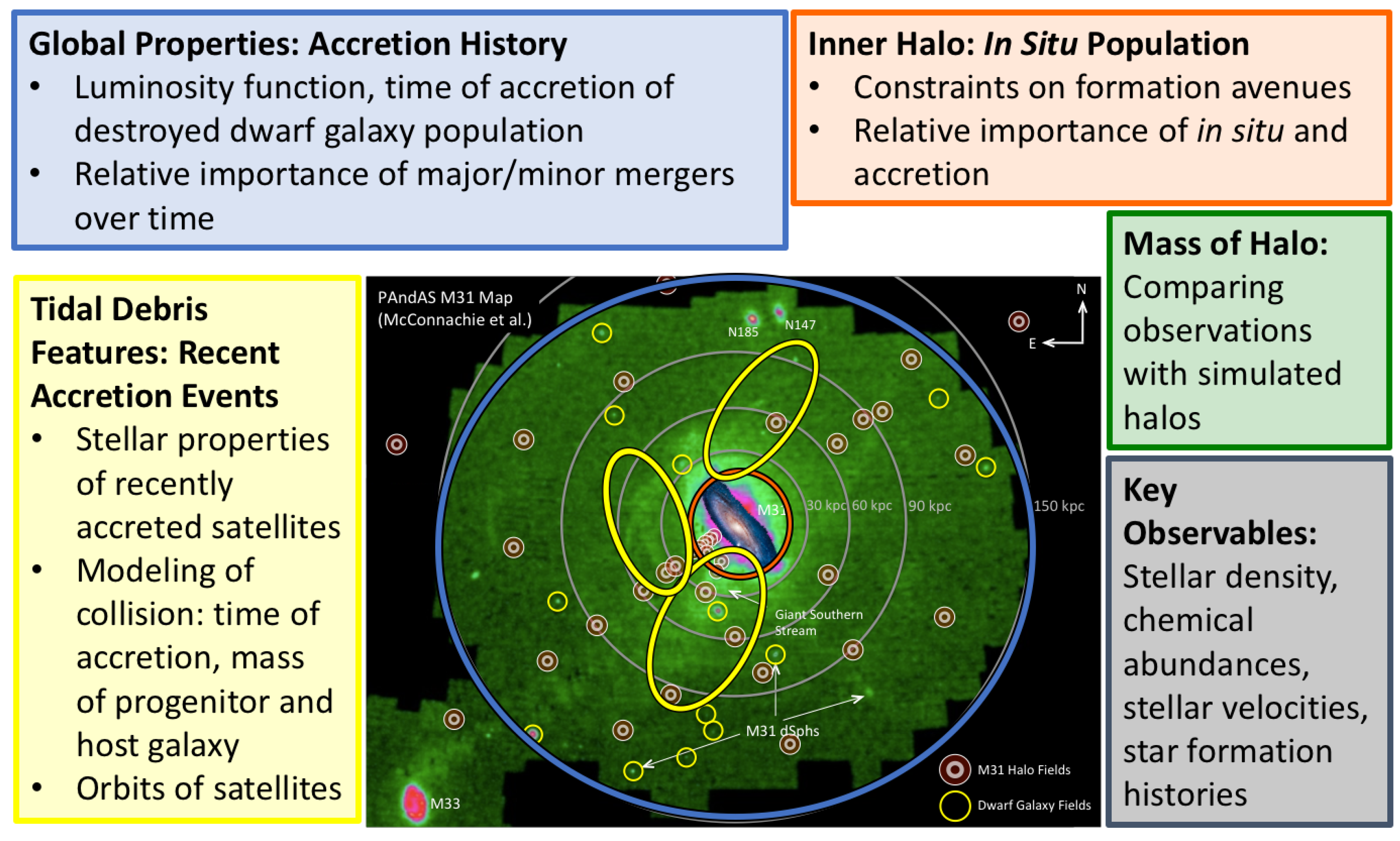
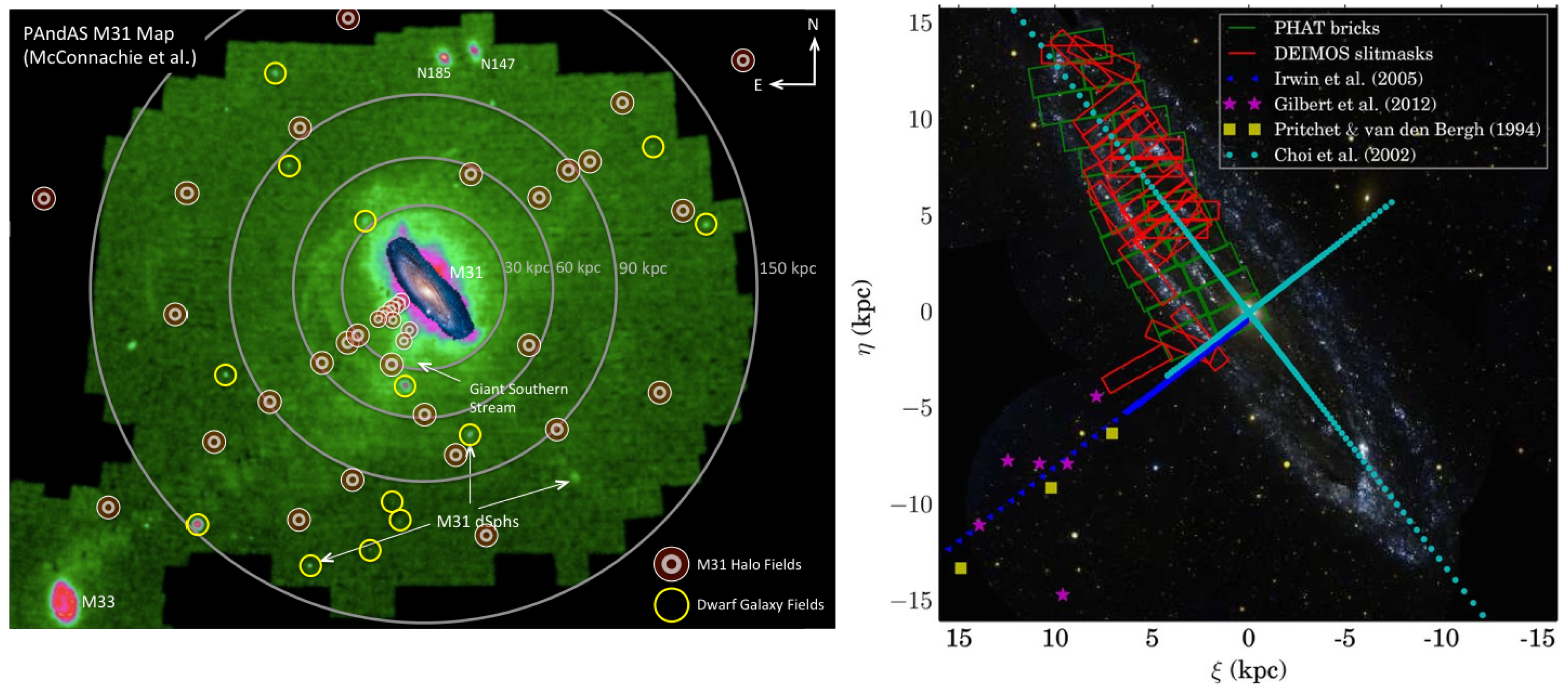
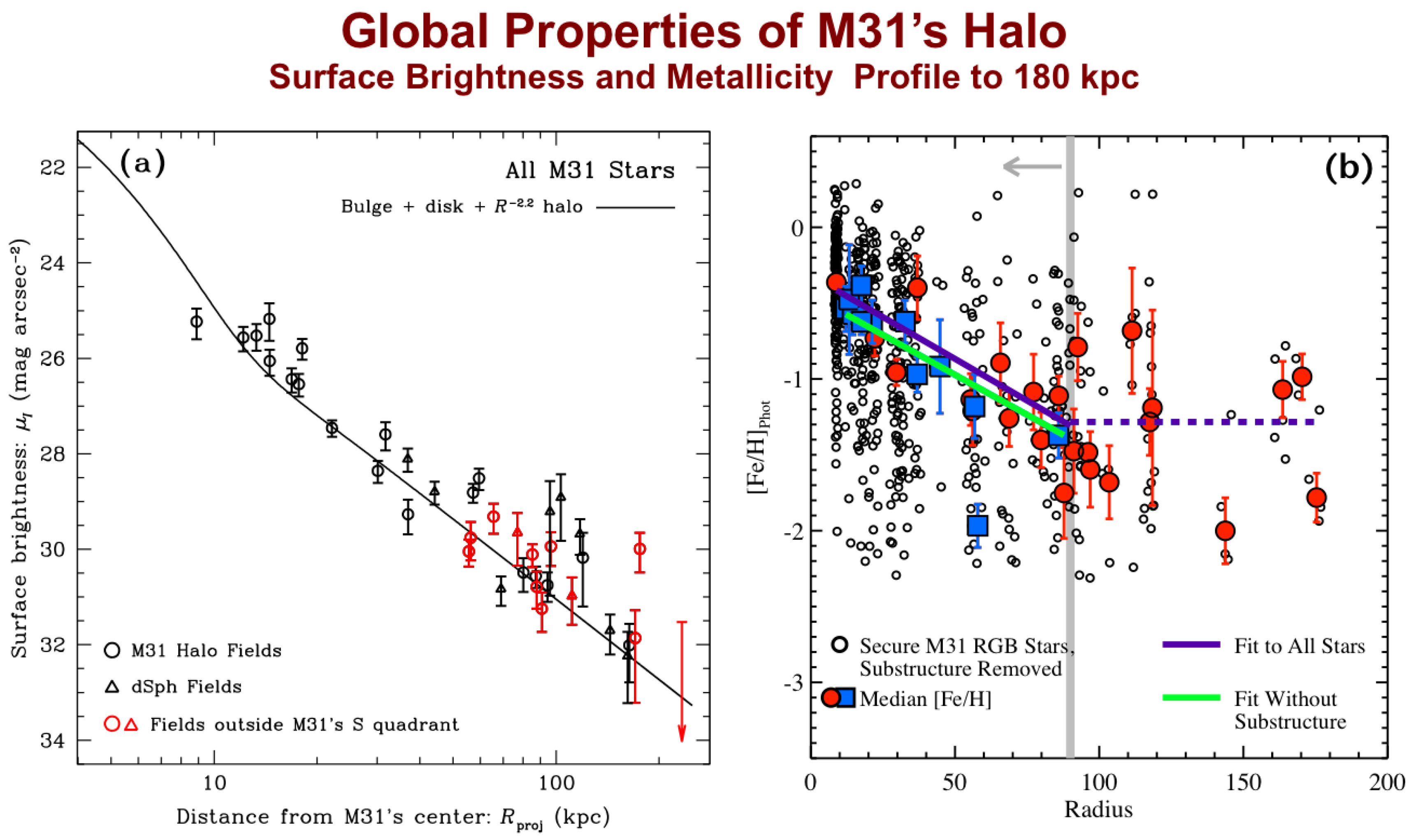
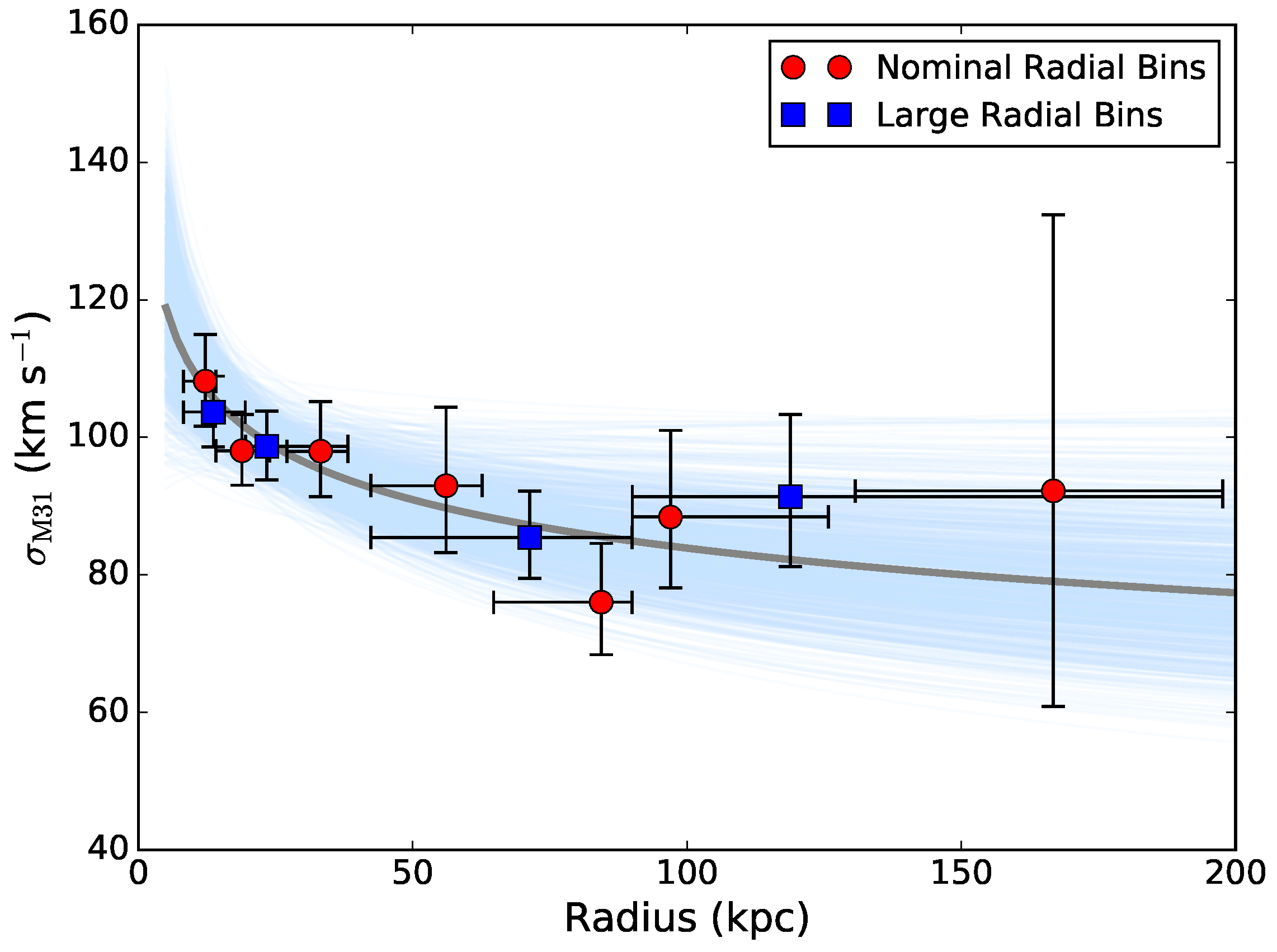
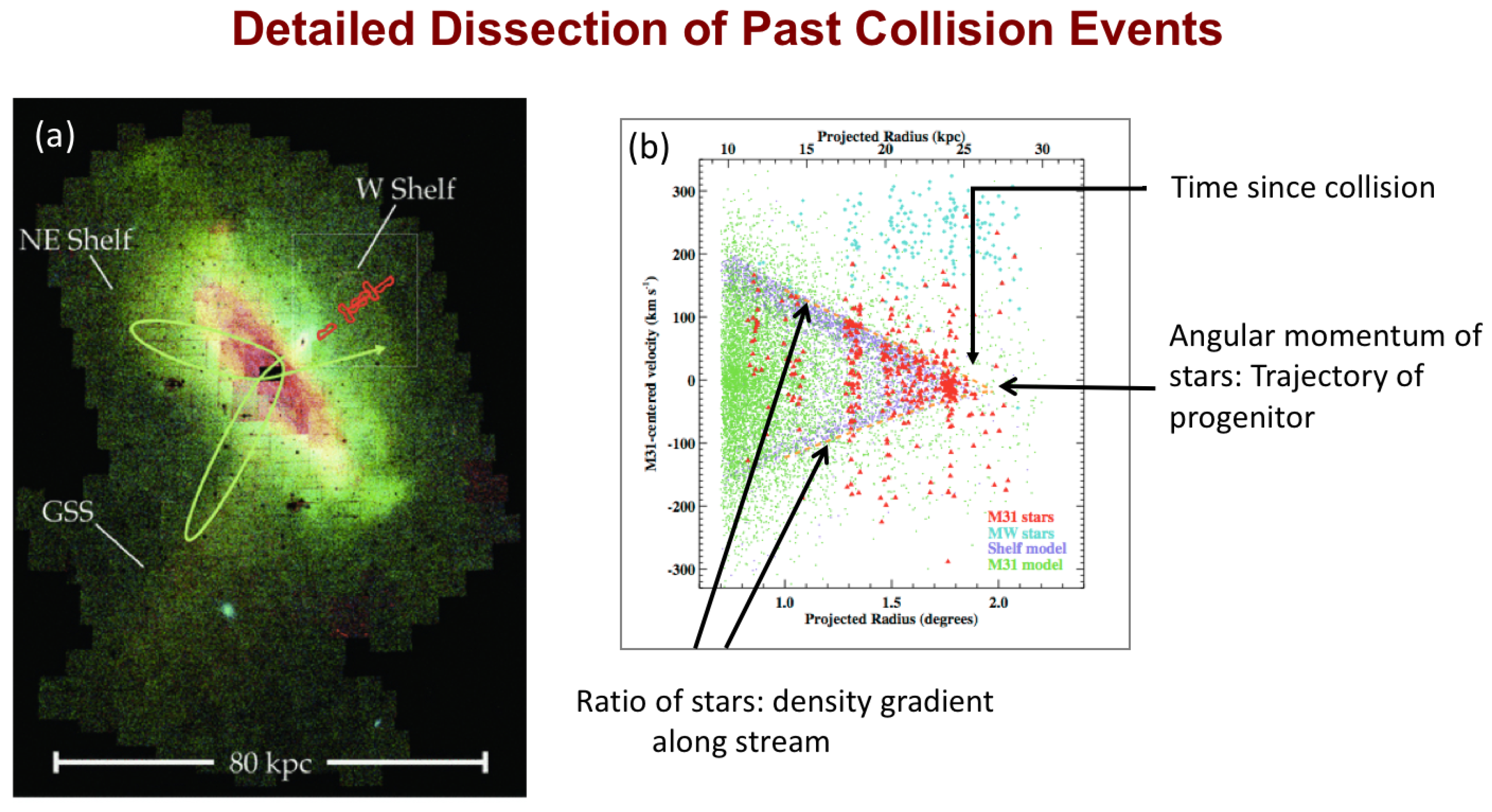
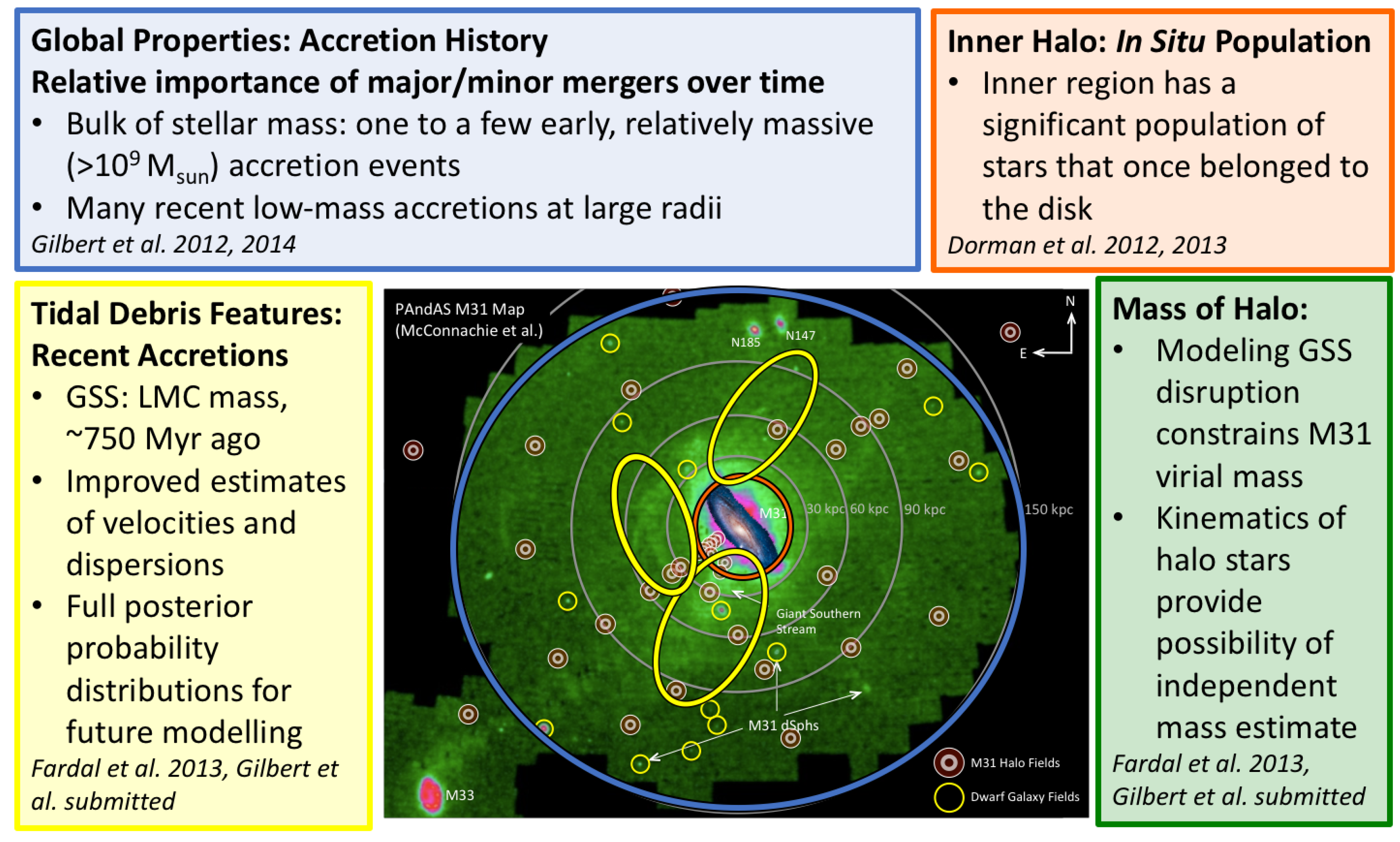
© 2017 by the author. Licensee MDPI, Basel, Switzerland. This article is an open access article distributed under the terms and conditions of the Creative Commons Attribution (CC BY) license (http://creativecommons.org/licenses/by/4.0/).
Share and Cite
Gilbert, K. Constraints on the Formation of M31’s Stellar Halo from the SPLASH Survey. Galaxies 2017, 5, 59. https://doi.org/10.3390/galaxies5040059
Gilbert K. Constraints on the Formation of M31’s Stellar Halo from the SPLASH Survey. Galaxies. 2017; 5(4):59. https://doi.org/10.3390/galaxies5040059
Chicago/Turabian StyleGilbert, Karoline. 2017. "Constraints on the Formation of M31’s Stellar Halo from the SPLASH Survey" Galaxies 5, no. 4: 59. https://doi.org/10.3390/galaxies5040059





